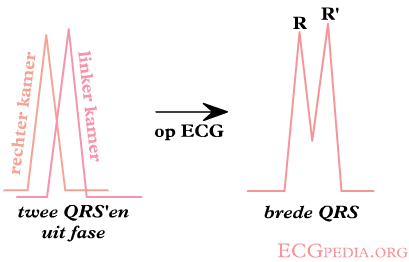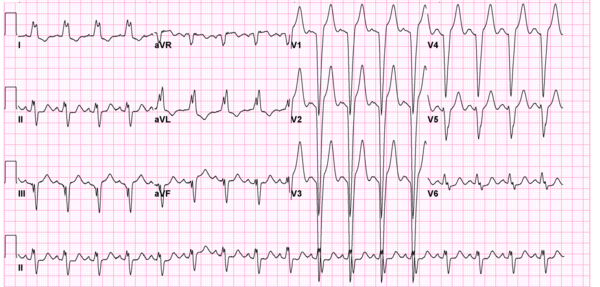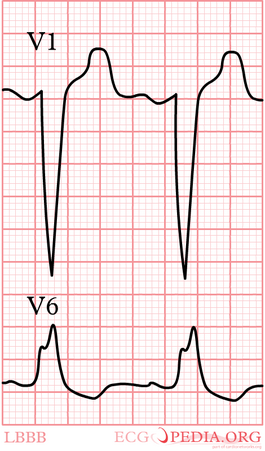Intraventricular Conduction: Difference between revisions
| Line 31: | Line 31: | ||
==Right Bundle Branch Block (RBBB)== | ==Right Bundle Branch Block (RBBB)== | ||
{:RBBB} | |||
==Left Anterior Fascicular Block (LAFB)== | ==Left Anterior Fascicular Block (LAFB)== | ||
Revision as of 08:31, 23 July 2007
| Author(s) | J.S.S.G. de Jong, MD | |
| Moderator | J.S.S.G. de Jong, MD | |
| Supervisor | ||
| some notes about authorship | ||
Conduction delay
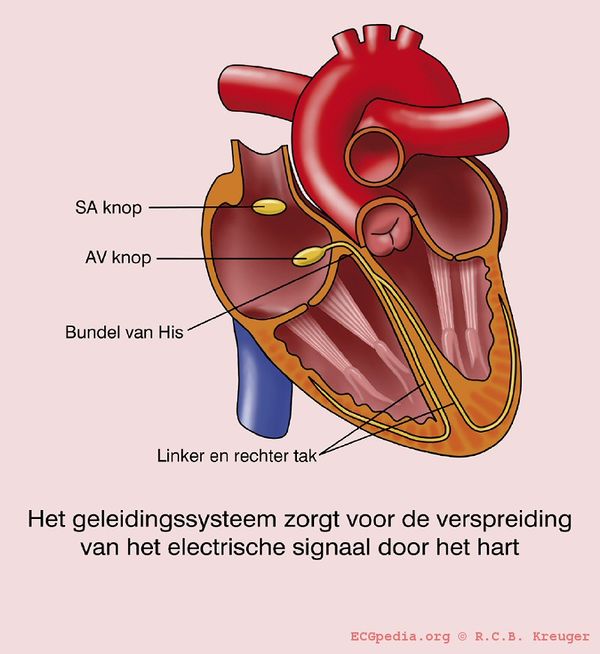
If the QRS complex is wider than 0.12 seconds this is mostly caused by a delay in the conduction tissue of one of the bundle branches:
- Left Bundle Branch Block (LBBB))
- Right Bundle Branch Block(RBBB)
- Interventricular conduction delay
A right or left axis rotation can be caused by a:
Sometimes this conduction delay is frequency-dependent : the bundle branch block occurs only at higher heart rates and disappears at slower heart rates.
LBBB vs RBBB

Check V1 when QRS > 0,12 sec.
When the last QRS in V1 is below the baseline (moving away from V1), a LBBB is the most likely diagnosis.
When the last activity is above the baseline, it's a RBBB.
If the QRS > 0.12 sec. but the morphological criteria of LBBB or RBBB do not apply, it is called 'interventriculair conduction delay', a general term.
Left Bundle Branch Block (LBBB)
- Criteria for left bundle branch block (LBBB) Garcia
- QRS >0,12 sec
- Broad monomorphic R waves in I and V6 with no Q waves
- Broad monomorphic S waves in V1, may have a small r wave
In left bundle branch block (LBBB) the conduction in the left bundle is slow. This results in delayed depolarization of the left ventricle, especially the left lateral wall. The electrical activity in the left lateral wall is unopposed by the usual right ventricular electrical activity. The last activity on the ECG thus goes to the left or away from V1. Once you remember this, LBBB is easy to understand.
Diagnosis of myocardial infarction in LBBB can be difficult.
Other definitions
The above definition of left bundle branch block is rather broad. In selecting patients for CRT-D therapy (cardiac resynchronization therapy) there has been debate whether a more specific definition should be used. In the RAFT trial the following AHA/ESC definition was usedTangESC-ECG:
Complete LBBB
- QRS duration greater than or equal to 120 ms in adults, greater than 100 ms in children 4 to 16 years of age, and greater than 90 ms in children less than 4 years of age.
- Broad notched or slurred R wave in leads I, aVL, V5, and V6 and an occasional RS pattern in V5 and V6 attributed to displaced transition of QRS complex.
- Absent q waves in leads I, V5, and V6, but in the lead aVL, a narrow q wave may be present in the absence of myocardial pathology.
- R peak time greater than 60 ms in leads V5 and V6 but normal in leads V1, V2, and V3, when small initial r waves can be discerned in the above leads.
- ST and T waves usually opposite in direction to QRS.
- Positive T wave in leads with upright QRS may be normal (positive concordance).
- Depressed ST segment and/or negative T wave in leads with negative QRS (negative concordance) are abnormal.
- The appearance of LBBB may change the mean QRS axis in the frontal plane to the right, to the left, or to a superior, in some cases in a rate-dependent manner.
Incomplete LBBB
- QRS duration between 110 and 119 ms in adults, between 90 and 100 ms in children 8 to 16 years of age, and between 80 and 90 ms in children less than 8 years of age.
- Presence of left ventricular hypertrophy pattern.
- R peak time greater than 60 ms in leads V4, V5, and V6.
- Absence of q wave in leads I, V5, and V6.
Also a narrow initial R wave in V1 has been linked with a reduced response to CRT.Mascioli
In general when the QRS is wide and the definitions of LBBB and RBBB are not met, the term NIVCD (non-specific intraventricular conduction delay) is used.
Also read right bundle branch block.
Right Bundle Branch Block (RBBB)
{:RBBB}
Left Anterior Fascicular Block (LAFB)
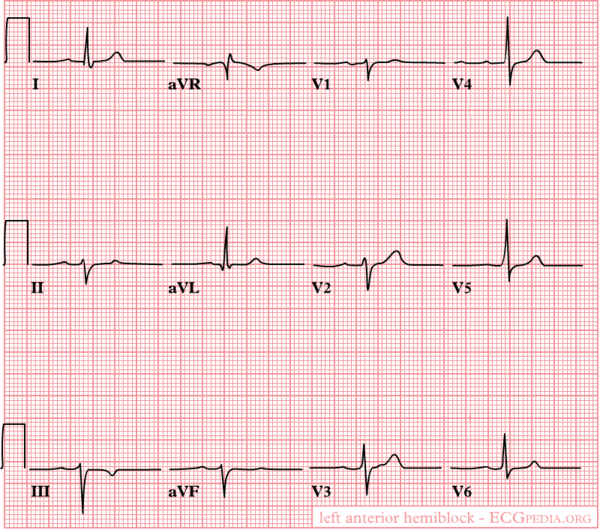
- Criteria for left anterior fascicular block
- left axis deviation (<-30°)
- no or very small S in lead I
- normal small q in lead I
- S > R in leads II and III
- no or very few QRS widening
In left anterior fascicular block the anterior part (fascicle) of the left bundle is slow. This results in delayed depolarisation of the upper anterior part of the left ventricle. On the ECG this results in left axis deviation. The QRS width is <0,12 seconds in isolated LAFB.
Left Posterior Fasicular Block (LPFB)
- Criteria for posterior fascicular block
- right axis devation >+120°;
- deep S in I;
- small q in III;
- no or very few QRS widening;
- Right ventricular hypertrophy and previous lateral myocardial infarction have been excluded
Mechanisms of aberrant conduction
- Aberrant ventricular conduction is defined as
- QRS widening due to delay or block in bundle branch or intramyocardial conductionwellens
Aberrancy can result from:
- A sudden fastening of the heart rate that the bundles cannot conduct (phase 3 aberration)
- Retrograde concealed conduction
- A slow heart rate (phase 4 aberration)
Right bundle branch block is most common, because the right bundle has the longest refractory period. Left bundle branch block accounts for about 1/3rd of cases.
Phase 3 Aberration
Phase 3 aberration occurs when conduction fibers receive a new impulse, before they have fully repolarized. This can sometimes be observed at the start of paroxysmal supraventricular tachycardias or in a long-short sequence where the refractory periode of the long sequence is prolonged.
Retrograde Concealed Conduction
Phase 3 aberration is often the cause of the first wide QRS complex. However at a regular rate retrograde concealed conduction is often the sustaining mechanism. The sequence of QRS widening that is often observed is phase 3 aberration in the first premature beat. This can leave the left bundle (as an example) refractory for the next beat. This next beat is conducted by the right bundle and once it reaches the apex, it is conducted retrograde by the left bundle. This can continue until a new premature ventricular beat causes a compensatory pause and 'resets' the system.
Phase 4 Aberration
Phase 4 aberration only occurs after prolonged pause. During such a pause (e.g. in second degree AV block) the fibers of the Purkinje system can 'hyper'-depolarize spontaneously. As their membrane potential becomes more and more negative the conduction velocity reduces and they can even block altogether. This also requires an upwards shift of the threshold membrane potential and a change in membrane responsiveness, so it is rarely seen in normal hearts.
References
<biblio>
- Garcia isbn=0763722464
- wellens isbn=9781416002598
</biblio>
